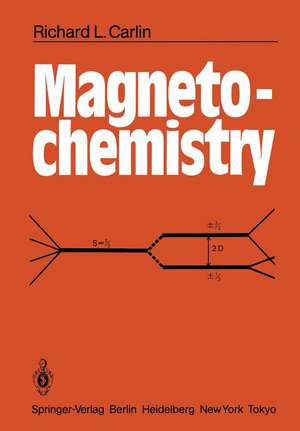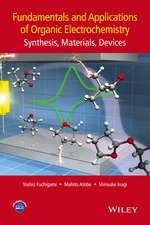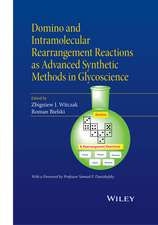Magnetochemistry
Autor Richard L. Carlinen Limba Engleză Paperback – 6 dec 2011
Preț: 580.41 lei
Preț vechi: 682.84 lei
-15% Nou
Puncte Express: 871
Preț estimativ în valută:
111.13€ • 115.72$ • 92.20£
111.13€ • 115.72$ • 92.20£
Carte tipărită la comandă
Livrare economică 13-27 februarie
Preluare comenzi: 021 569.72.76
Specificații
ISBN-13: 9783642707353
ISBN-10: 3642707351
Pagini: 344
Ilustrații: XI, 328 p.
Dimensiuni: 170 x 244 x 18 mm
Greutate: 0.6 kg
Ediția:1986
Editura: Springer Berlin, Heidelberg
Colecția Springer
Locul publicării:Berlin, Heidelberg, Germany
ISBN-10: 3642707351
Pagini: 344
Ilustrații: XI, 328 p.
Dimensiuni: 170 x 244 x 18 mm
Greutate: 0.6 kg
Ediția:1986
Editura: Springer Berlin, Heidelberg
Colecția Springer
Locul publicării:Berlin, Heidelberg, Germany
Public țintă
GraduateCuprins
1. Diamagnetism and Paramagnetism.- 1.1 Introduction.- 1.2 Diamagnetism.- 1.3 Atomic Term Symbols.- 1.4 Paramagnetism.- 1.5 Some Curie Law Magnets.- 1.6 Curie-Weiss Law.- 1.7 Temperature Independent Paramagnetism.- 1.8 References.- 1.9 General References.- 1.10 Appendix.- 2. Paramagnetism: Zero-Field Splittings.- 2.1 Introduction.- 2.2 Van Vleck’s Equation.- 2.3 Paramagnetic Anisotropy.- 2.4 Spin-Orbit Coupling.- 2.5 Effective Spin.- 2.6 Direct Measurement of D.- 2.7 Electron Paramagnetic Resonance.- 2.8 References.- 3. Thermodynamics.- 3.1 Introduction.- 3.2 Thermodynamic Relations.- 3.3 Thermal Effects.- 3.4 Adiabatic Demagnetization.- 3.5 Schottky Anomalies.- 3.6 Spin-Lattice Relaxation.- 3.7 References.- 4. Paramagnetism and Crystalline Fields: The Iron Series Ions.- 4.1 Introduction.- 4.2 Magnetic Properties of Free Ions.- 4.3 Quenching of Orbital Angular Momentum.- 4.4 Coordination Compounds.- 4.5 Jahn-Teller Behavior.- 4.6 The Iron Series Ions.- 4.7 References.- 5. Introduction to Magnetic Exchange: Dimers and Clusters.- 5.1 Introduction.- 5.2 Energy Levels and Specific Heats.- 5.3 Magnetic Susceptibilities.- 5.4 Copper Acetate and Related Compounds.- 5.5 Some Other Dimers.- 5.6 EPR Measurements.- 5.7 Clusters.- 5.8 The Ising Model.- 5.9 References.- 6. Long-Range Order. Ferromagnetism and Antiferromagnetism.- 6.1 Introduction.- 6.2 Molecular Field Theory of Ferromagnetism.- 6.3 Thermal Effects.- 6.4 Molecular Field Theory of Antiferromagnetism.- 6.5 Ising, XY, and Heisenberg Models.- 6.6 Dipole-Dipole Interactions.- 6.7 Exchange Effects on Paramagnetic Susceptibilities.- 6.8 Superexchange.- 6.9 Field Dependent Phenomena.- 6.10 Ferromagnets.- 6.11 Ferrimagnetism.- 6.12 Canting and Weak Ferromagnetism.- 6.13 Characteristic Behavior of the 3d Ions.- 6.14References.- 7. Lower Dimensional Magnetism.- 7.1 Introduction.- 7.2 One-Dimensional or Linear Chain Systems.- 7.3 Long-Range Order.- 7.4 Alternating Linear Chains.- 7.5 Spin-Peierls Systems.- 7.6 Two-Dimensional or Planar Systems.- 7.7 CaCu(0Ac)4 · 6H20.- 7.8 Metamagnetism.- 7.9 Canting and Weak Ferromagnetism.- 7.10 Some Ferromagnetic Linear Chains.- 7.11 Solitons.- 7.12 References.- 8. The Heavy Transition Metals.- 8.1 Introduction.- 8.2 Molybdenum (III).- 8.3 Ruthenium (III).- 8.4 Rhenium (IV).- 8.5 Osmium (III).- 8.6 Iridium (IV).- 8.7 References.- 9. The Rare Earths or Lanthanides.- 9.1 Introduction.- 9.2 Cerium.- 9.3 Praseodymium.- 9.4 Neodymium.- 9.5 Samarium.- 9.6 Europium.- 9.7 Gadolinium.- 9.8 Terbium.- 9.9 Dysprosium.- 9.10 Holmium.- 9.11 Erbium.- 9.12 Thulium.- 9.13 Ytterbium.- 9.14 Some Other Systems.- 9.15 References.- 10. Selected Examples.- 10.1 Introduction.- 10.2 Hydrated Nickel Halides.- 10.3 Tris (dithiocarbamates) of Iron (III).- 10.4 Spin-3/2 Iron (III).- 10.5 Manganous Acetate Tetrahydrate.- 10.6 Polymerie NiX2L2.- 10.7 Hydrated Nickel Nitrates.- 10.8 The Pyridine N-Oxide Series.- 10.9 The A2[FeX5(H20)] Series of Antiferromagnets.- 10.10 Some Dilution Experiments.- 10.11 Biomagnetochemistry of Cobalt (II).- 10.12 References.- 11. Some Experimental Techniques.- 11.1 Introduction.- 11.2 Specific Heat Measurements.- 11.3 Gouy and Faraday Balances.- 11.4 Susceptibilities in Alternating Fields.- 11.5 Anisotropic Susceptibilities.- 11.6 References.- Formula Index.
Textul de pe ultima copertă
This book deals with the electronic structure of transition metal complexes as revealed by their magnetic properties. Paramagnetic phenomena are reviewed, but the emphasis throughout the book lies with magnetic ordering phenomena, in both low-dimensional systems as well as with systems undergoing long-range ordering. Field dependent properties are described, and percolation phenomena are introduced. Experimental procedures are also discussed.
Caracteristici
Still one of the leading textbooks in the field Richly illustrated by 244 figures Covers paramagnetic and magnetic ordering phenomena as well as experimental procedures











